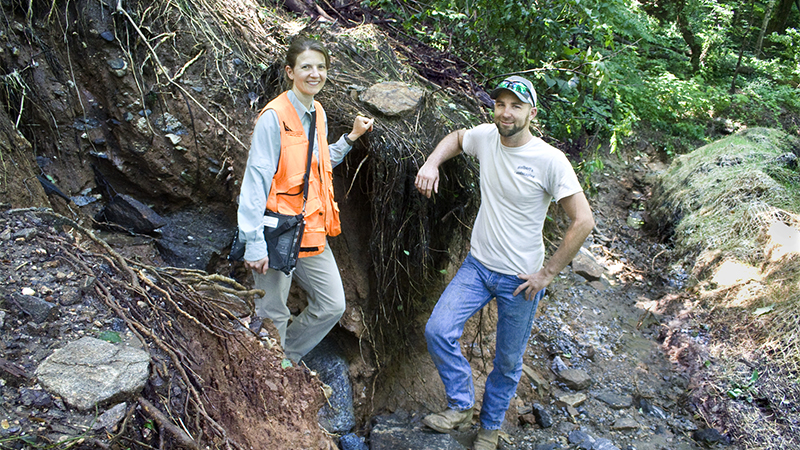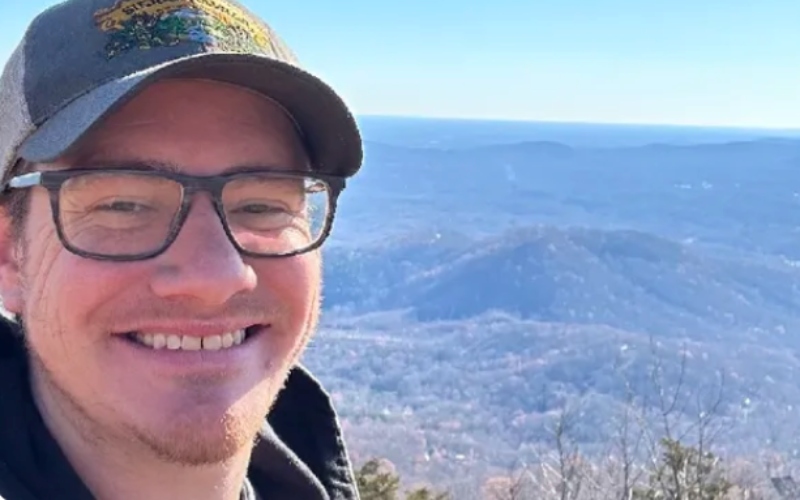The what, why of recent Warrior Mountain mudslides
Published 8:00 am Friday, June 8, 2018

- Jonathan Holbert and Jennifer Bauer climbed to the top of Big Warrior Mountain to find and inspect the source of Harry Goodheart’s recent property damage and map the debris flow track. (Photo by Vincent Verrecchio)
Area geologist digs into cause of last month’s calamity
Driving home from dinner on Friday night, May 18, the windshield wipers of Harry Goodheart’s Subaru swiped with little effect.
The rain, with the intensity and sound of a waterfall, sheeted the glass in a blur despite the speed of the blades. Stopping at the bottom of his steep uphill driveway, Goodheart leaned forward over the steering wheel, squinting to understand what was coming down at him through the darkness.
Trending
Even after he got out for a clearer view, his reaction was “what the hell?”

Big Warrior Mountain debris flow tracks identified and mapped by Bauer, principal geologist, Appalachian Landslide Consultants PLLC of Asheville. (Submitted graphic)
The driveway was a churning stream of broken waves and black troughs. Still not comprehending what was happening, he pushed forward against the knee-high current, not knowing that wood and rock debris roiling in the water around his legs could scrape and bruise, knowing only that he had to get up to his house and save Lila, his Carolina dog.
When he got into the dark house, she was panicked but came to him. Fleeing with Goodheart into the storm, she slipped leash twice before they both got back down to the car.
The next day, he could see some of what had happened. A wide debris flow track had ripped into his backyard from an unseen height up Warrior Mountain.

Debris flow (mudslide) schematic. Actual proportions will vary based on the specific event. (Submitted graphic)
Soupy mud, broken trunks and limbs, and twisted vegetation had rushed down, widening a swath and gouging a chute. With it came stones and rocks seemingly too large to have been moved by water.
Amazingly, a boulder — later estimated to weigh about two tons — had settled on his well cap cover, crushing it flat. His RV van, parked across the back corner of his home had taken the brunt of the mudflow, deflecting some of it to either side. Sludge had deposited up and under the vehicle and over the running boards.
Trending
To one side, 2 feet of mud had pushed by, piling up above the hubs of his nearby pickup. To the other side, muck had surged against a lower level door before sweeping around and down the driveway.
With an idea of “what” had happened, he wanted to know “why.” Not the “why me, Lord” question, but more technical questions of “why” and “how” did it happen, and then, “what” can be done to help prevent a reoccurrence.
Looking into the landslides
For answers, Goodheart contacted Jonathan Holbert, of Holbert’s Landscaping in Columbus, and Jennifer Bauer, principal geologist at Appalachian Landslide Consultants PLLC in Asheville.
“Jonathan knew the first thing to do was build a berm across the mountain side on my property above the house,” Goodheart said. “More rain was in the forecast, and a berm could help prevent further damage. I am not totally clear on how he got his excavator and small dozer up the face of that 45-degree muddy slope, but he did. Skill, guts and luck built that berm to beat the next rain.”
Goodheart’s berm, almost 4-foot high, is an asymmetrical mound with sloped sides running almost the width of his property. The bulk of the mound is rocky/clay fill under a layer of clay.
Topsoil over the clay will eventually be stabilized with vegetation. For now, straw under geomesh helps hold the soil in place. The slope on the side away from the flow is steeper than the side facing into the flow. The velocity of a flow down the chute will dissipate when splashing into the trench behind the berm and washing up the gentler slope, like a wave coming up a beach rather than slamming into a wall.
The water flow splits left and right, the volume and energy redirected along the trench and bypassing the home below.
“When the rains came again, the berm worked, but I still wanted to know what happened up there,” Goodheart said.
Finding some answers
“The high point of the ridge above Harry’s is at about 2,340 feet. His home here is about 1,340 feet.” Bauer said.
She and Holbert had climbed to the top of the ridge to find and inspect the source of Goodheart’s problem and map the debris flow track.
“We personally found multiple initiation zones… the point where a slide falls away from the ground surface,” she said.
She further explained terms found in a United States Geological Survey schematic that illustrates, in general, the features of mudslide events. She and Holbert also found multiple debris flow tracks in addition to the chute into Goodheart’s backyard.
“The largest track we found is 2,300 feet long and up to 75-80 feet wide,” she said.
A track does not necessarily run straight downhill, so it can be longer than the straight-line distance from the crown to Goodheart’s yard.
“We found no soil movement due to grading,” she said. “There are logging trails, but they’re old, and deciduous growth and vegetation are established. Based on what we found, we think that what happened up there was natural.”
Bauer added that such events are common.
“There are over 3,600 known landslides since 1916 in a database created by ALC and The North Carolina Geological Survey, but there are uncounted more that were undetected or never recorded.”
One detailed answer to “what happened up there”? is that the pore pressure exceeded soil cohesion at the initiation zone and gravity exerted enough shear stress to separate the saturated soil from the bedrock.
Pore pressure is the pressure of water in gaps between particles of soil or rock; the more water, the greater the pressure to push particles apart. A simpler answer is that intense rain liquefied the ground layer(s) closer to the surface and water runs downhill.
The USGS estimates that 5 inches of rain within 24 hours could be enough for soil to move, depending on slope angle and soil type. That night on Warrior Mountain, some sources report estimates of 5 to 8 inches in three hours.





